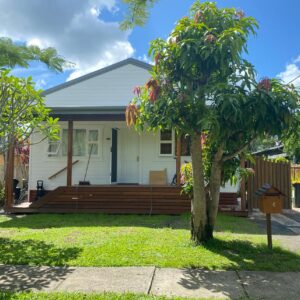Description
To book a ticket to view this home, visit the Flood Resilient Open Home Morning Session Booking Page. Home addresses will be provided after booking is confirmed.
The purpose of this event is for people to increase their understanding of flood resilient retrofitting techniques and materials – particularly for homes that can’t be lifted like brick veneer slab on ground homes.
This house flooded to approximately 900mm.
Gemma will tell you about how the flood impacted her house and granny flat and what the rebuild involved. She will share with you tips and tricks that she recommends and what she may have done differently with the benefit of hindsight. She will be joined via the magic of Facetime by her son, Leif, who undertook much of the building works and made bold technique decisions after consulting directly with JDA Co in Brisbane. Leif is studying architecture in Melbourne and has a particular interest in the inherent properties of different building materials.
Everything Gemma & Leif say is to be received as simply their story and any recommendations purely their opinion as the homeowners and family of. Mullum Cares hasn’t had Gemma’s house or granny flat assessed to prove any statements that they or any part thereof are guaranteed to be water or flood proof so you must receive the information from Gemma & Leif as simply an account of their experience and decision making processes.
The table below lists the elements at this home that correlate with items in the NSW Northern Rivers Reconstruction Corporation’s Flood Resilient Design Framework. This correlation does not mean that the NRRC has assessed or approved the works as resilient; it simply highlights elements of particular interest at this home. You can download the Flood Resilient Design Framework here. This framework has been developed to support the NSW Resilient Homes Program – more information here.
| Checklist # | Strategy description | Materials used |
| 3 | Replace loose-fill insulation with rigid insulation | In the granny float the loose fill insulation was replaced with rigid. |
| 4 | Replace non flood resilient wall linings with flood resilient wall linings | FC (fibre cement sheeting) replaced gyprock on bottom half of walls throughout. Pioneering idea to leave gap between top and bottom wall panel big enough to allow hose nozzle in to clean wall sheet without removing. |
| 13 | Replace non flood resilient skirtings with flood resilient skirtings | A technique rather than flood resilient material was employed to leave a gap in the wall lining at the bottom covered by a high skirting board that is screwed on allowing for easy removal and easy clean out under walls, radically more air flow to speed up the drying process. |
| 15 | Use solid core doors instead of hollow core doors | Some doors that were hollow core have been replaced with solid core doors. |
| 17 | Replace cavity sliding doors with swing or face of wall sliding doors | The bathroom behind the garage conversion had a hollow core cavity sliding door – now it is a barn style slider with solid core door. |
| 20 | Install flood resilient cabinetry | Kitchen is stainless steel open shelves. |
| 21 | Allow the kickboard to be removable | No kickboard |
| 22 | Install raised cabinetry | Bathrooms have wall hung cabinets |
| 23 | Install a removable panel or replace cavity bathtubs with freestanding bathtubs or showers | Bath replaced with a free standing one. |
| 24 | Raise kitchen appliances if possible | The oven is now above the benchtop instead of below |
| 25 | Elevate appliances | In the laundry a cabinet has been made for the washing machine and dryer to sit on (above flood height). The cabinet is expected to survive inundation. |
| 28 | Elevate powerpoints | All powerpoints raised |
| Still planning on doing | ||
| 11 | Use flood resilient grout when tiling or re-tiling wet areas | |
| 6 | Add additional weep holes to double brick and brick veneer walls | An experimental technique to remove some bricks to allow the cavity along the perimeter bathroom wall to drain and dry after a future flood is part of Gemma’s flood action plan. As the house is hardwood framed it is hoped that this will allow the bathroom to remain intact. |



